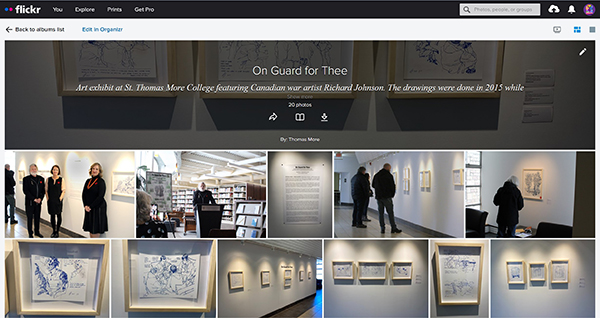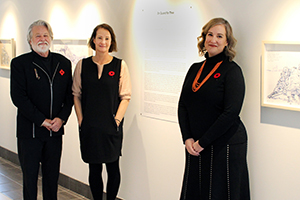
Exhibit chronicles Canadian role in training Ukrainian defenders
On Guard for Thee showcases drawings of war artist Richard Johnson; fundraiser aimed at surgical mission of mercy
By Paul SinkewiczThe peaceful art gallery of St. Thomas More College is situated in a hallway just outside the doors of the school’s library, where its students are serenely studying. They are perhaps thinking ahead to weekend activities with friends.
On the other side of the world, in Ukraine, young men and women of the same age are literally being shredded by shrapnel from rocket attacks. Some are making the ultimate sacrifice to protect their homeland, others are being taken off the battlefield horribly disfigured. All have had their lives forever upended by Russia’s invasion.
Yet the peaceful Canadian hallway, and the tragic conflict in Ukraine are connected.
An art exhibit featuring the drawings of war artist Richard Johnson is drawing attention to Canada’s military contribution to the defence of Ukraine and raising money to repair wounds suffered in the conflict.
On Guard for Thee is a remarkable exhibition of prints representing Canada’s Operation Unifier training mission in Ukraine, which began in 2015. The show was mounted by STM Gallery curator Linda Stark, in partnership with the Prairie Centre for the Study of Ukrainian Heritage (PCUH).
“Since Feb. 24, our community has focused on our connections with our ancestral homeland in a whole new way,” said Dr. Nadya Foty-Oneschuk, interim director of PCUH, at the opening of the exhibit. “Standing shoulder-to-shoulder with our brothers and sisters in Ukraine, Ukrainians all over the world, including those of us here in Saskatchewan, are working to raise awareness about the genocidal war happening in Ukraine, and to help raise funds to ensure that humanitarian aid will get to those who so desperately need it.”
“The PCUH is proud of our founding director, Professor Emeritus Dr. Bohdan Kordan, who curated this exhibit and who initiated the work to bring the partnership with Linda Stark and the STM Gallery to fruition,” she said.
“Not only does this exhibit speak for itself in terms of the profound artistic talent being showcased, but it also serves as a fundraiser for this very important cause.”
Dr. Kordan said the exhibit was meant to inform students, but also the wider University community and beyond.
“Very little has been said of Canada’s contribution to the defence of Ukraine,” he said. “Canada has done exceptional work in making that possible.”
Dr. Kordan has been following Johnson’s work for about 10 years. Johnson, a renowned war artist, works with both the Canadian and U.S. militaries, and his work appears in prestigious national publications and news outlets in both countries. His illustrations can be found in the Canadian War Museum and the Smithsonian Museum for American History, among others.
A Canadian now living in Scotland, Johnson said it is an emotional thing to watch one country attempt to dismantle another country through force of arms.
“The fact that it all seems so pointless, from my perspective at least, makes it all the more sad,” he said. “They are slaughtering young men and women with heavy weapons. It’s just an atrocious waste of life.”
Johnson said the bulk of the people who are doing the dying are young men and women just out of their teenage years.
“The other people who are doing the dying are the civilian population, of course.”
Johnson was in Ukraine for three weeks in 2015, during the first rotation of the Canadian trainers. They were instructing soldiers who has come straight from the front lines of the conflict, which began in 2014, in the east of the country.
While he was there, Johnson observed the Canadians teaching advanced infantry and armour techniques, as well as how to treat and evacuate casualties in the field under fire.
“I would say that over the last seven years, all of that training has made a massive difference in not just the cohesion of the Ukrainian forces but their confidence and skill level in this modern war fighting environment.”
“In the time I was there they had an excellent rapport with the Ukrainians, and the Ukrainians – as exhausted as many of them were – were keen to absorb everything the Canadians could teach.”
Each of the limited series prints in this collection is for sale, with all proceeds going toward the Canada-Ukraine Foundation Surgical Aid Program (CUSAP).
“This is for reconstructive surgery for civilians as well as veterans,” said. Dr. Kordan. “It supports volunteer Canadian surgeons who are going over to Ukraine to – as much as they can – make the lives of the people who have been victimized by the war better.”
Dr. Carl Still, President of STM College, called the exhibit timely, and thanked Dr. Kordan for his expert curation. He said the drawings had only grown in significance and poignancy since they were first made.
“It’s not difficult to draw a line between these images and the images we see on the news every day coming out of Ukraine,” said. Dr. Still.
“These drawings give us a glimpse into the realities of military training when the threat is real, and the stakes are high. They remind us that the defence of Ukraine did not begin earlier this year, but has been going on for several years now. And they give us a tangible opportunity to support humanitarian relief efforts in Ukraine.”
Those interested can contact Dr. Foty-Oneschuk to purchase one of the pieces. (nfoneschuck@stmcollege.ca).
“Please remember that taking one of these pieces home with you following the exhibit’s conclusion on Dec. 16 would not only provide an entirely unique statement piece in your collection, but one which goes directly to benefitting Ukraine itself,” she said.
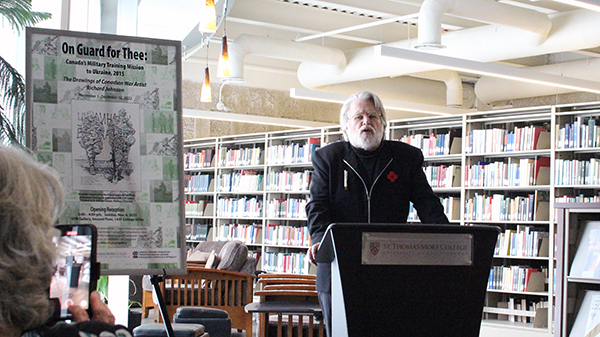
About the Canada-Ukraine Foundation
Canada-Ukraine Foundation (CUF) was established in 1995 to coordinate, develop, organize and deliver assistance projects generated by Canadians and directed to Ukraine and to the Ukrainian diaspora in Canada.
In September, a team of 30 Canadian medical professionals travelled to Czeladz, Poland to treat Ukraine’s victims of war.
After five days of surgery, over 40 extremely complex procedures were performed. The surgeries focused on the reconstruction of defects and deformities of the face, craniofacial skeleton, and upper and lower extremities. The origin of the deformities varied, including military and civilians, but all were war casualties.
The stories shared by the patients left a mark on the whole team. From a young soldier who was the only survivor after an attack on his brigade, to the woman who lost her home and nearly her life when a missile hit her village on a bright summer day.
The next CUSAP mission is being planned for the end of the year.
https://www.cufoundation.ca/canada-ukraine-surgical-aid-program/
https://www.cufoundation.ca/canada-ukraine-surgical-aid-program-2/
About Richard Johnson
https://en.wikipedia.org/wiki/Richard_Johnson_(war_artist)
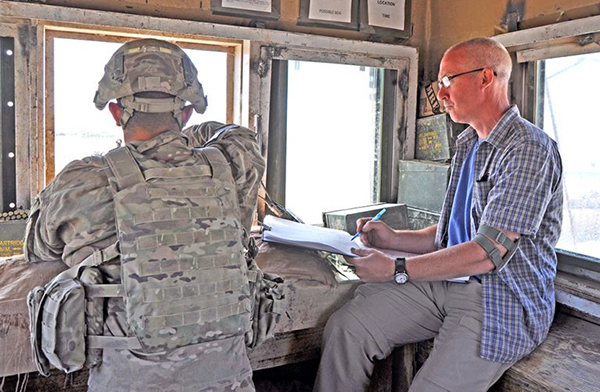
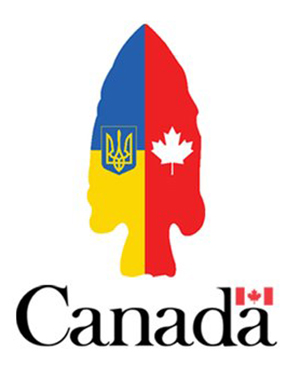
About Operation UNIFIER
Operation UNIFIER is the Canadian Armed Forces (CAF) mission in support of the Security Forces of Ukraine. The operation’s focus is to assist with security force training. This will help them improve as well as build their capability and capacity to repel the Russian invasion. The CAF coordinates its efforts with other partners and allies such as the United Kingdom, the United States and other countries that give support in the same way. Military training is one part of Canada’s overall support to Ukraine.
The CAF launched Operation UNIFIER in response to requests from the Government of Ukraine. The intent is to help Ukraine remain free, sovereign, secure, and stable.
Between 2014 and 2022, Canada has provided Ukraine with more than $890 million in multifaceted assistance to support Ukraine’s security, prosperity, and reform objectives.
Canada’s help to Ukraine also included supplying non-lethal military equipment. This is an ongoing process and includes equipment such as:
- communications systems used for field operations
- a mobile field hospital
- explosive disposal equipment
- medical kits used for military field operations
- night vision goggles
- personal protective and load carriage equipment
- surveillance and detection equipment
- winter clothing
This equipment continues to help improve the capabilities of the Security Forces of Ukraine.
Since February 2022, Canada has provided Ukraine with more than $500 million in emergency assistance to assist Ukraine in fighting and defeating the Russian invasion of its territory.
Canada’s help to Ukraine has included supplying protective equipment and weapons. This is an ongoing process and includes equipment such as:
- body armour, helmets and night vision gear
- meal packs
- drones and cameras
- commercial and military vehicles
- M72 and Carl Gustaf anti-tank weapons
- M777 artillery pieces
- small arms, anti-tank and artillery ammunition
The equipment is used to fight the Russian invaders and defend the sovereignty of Ukraine.
As of August 2022, approximately 210 CAF trainers have resumed delivering training to the Armed Forces of Ukraine (AFU) recruits in the UK. CAF trainers will take part in the training of approximately 10 000 recruits, in a training area located in the Southeast of the UK.
Operation UNIFIER Timeline
April 14, 2015
The Government of Canada announced that Canada would send about 200 CAF members to Ukraine. The mission would run until March 31, 2017.
September 14, 2015
Dual ceremonies were held in Ukraine. They marked the start of the CAF military training mission. One was held in Starychi. The other in Kamyanets-Podilsky.
November 23, 2015
Canada, Lithuania, Ukraine, the United Kingdom and the United States held a parade. This marked the stand-up of the Joint Multi-National Training Group – Ukraine headquarters. The HQ is in Starychi.
March 6, 2017
The Government of Canada announced that it has extended Operation UNIFIER until the end of March 2019.
March 2017
About 200 Canadian Army members deployed to relieve their counterparts. Both groups (deploying and coming back) were mainly from the 3rd Canadian Division.
May 18, 2018
The Department of National Defence/ Canadian Armed Forces signed a Technical Arrangement with the Ministry of Interior of Ukraine.
March 18, 2019
The Government of Canada announced that it has extended Operation UNIFIER until the end of March 2022.
September 2020
Canadian Special Operations Forces Command (CANSOFCOM) personnel joined Joint Task Force Ukraine in support of existing training development and capacity building efforts.
May 2021
Joint Task Force – Ukraine moved into its new Operation UNIFIER Headquarters located in Kyiv, Ukraine. The mission Headquarters were previously located at the International Peace and Security Center in Yavoriv.
January 26, 2022
The Government of Canada announced that it has extended and expanded Operation UNIFIER until the end of March 2025.
February 12, 2022
Canada pauses training operations in Ukraine and relocates Op UNIFIER members outside of Ukraine.
March 18, 2022
All members of Operation UNIFIER have returned to Canada until the resumption of training activities can take place.
August 15, 2022
Members of Operation UNIFIER arrive in the UK to resume the training of AFU recruits.
October 24, 2022
Members of Operation UNIFIER arrive in Poland to support a sapper training program for the Armed Forces of Ukraine.
Operation UNIFIER Photo Galleries
https://www.flickr.com/photos/cfcombatcamera/albums/72157663296796923

